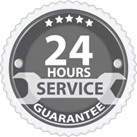Life Save Boat
Life boat is the ship’s main life-saving tool, it is the ship’s crew used for self-rescue or rescue at sea personnel in distress special Life Save Boat. An air chamber is installed under the inner seat plate to ensure that the boat will not sink even if it is fully filled with water. The boat is equipped with food, drinking water, first-aid medicine, equipment, communication equipment and propulsion equipment such as sails, OARS and poles, some of which are also equipped with motorized propulsion devices.
If you want to learn more about cargo ship lifeboat, you can write our blog: Choose The Right Inflatable Life Raft For Your Boat To Ensure Safety At Sea.
Our Ship Lifeboat for Sale
6P Rescue/lifeboat Boat
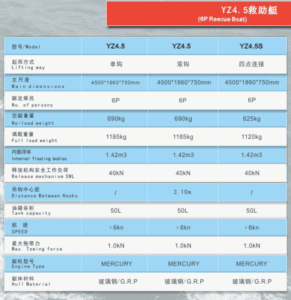
Totally Enclosed Lifeboat/Rescue boat
We offer regular and fire-resistant lifeboats, which can be categorized based on capacity into 26, 36, 39, 60, and 85-person enclosed lifeboats.
Name | Enclosed Lifeboat/Rescue Boat |
Model | YZ50C/F (C: Common) / (F: Fire-resistant) |
Main dimensions | 5.00*2.20*1.20m |
No. of persons | 26P Lifeboat/6P Rescue boat |
No-load weight | 2110/2405 |
Full load weight | 4225/4550 |
Release mechanusm (SWL) | 80 |
Tank capacity | 190 |
Speed | >6 |
Max. Towing force | 2.6 |
Engine Type | 380j-3 |
Hull material | Fire-retardant G.F.R Plastic |
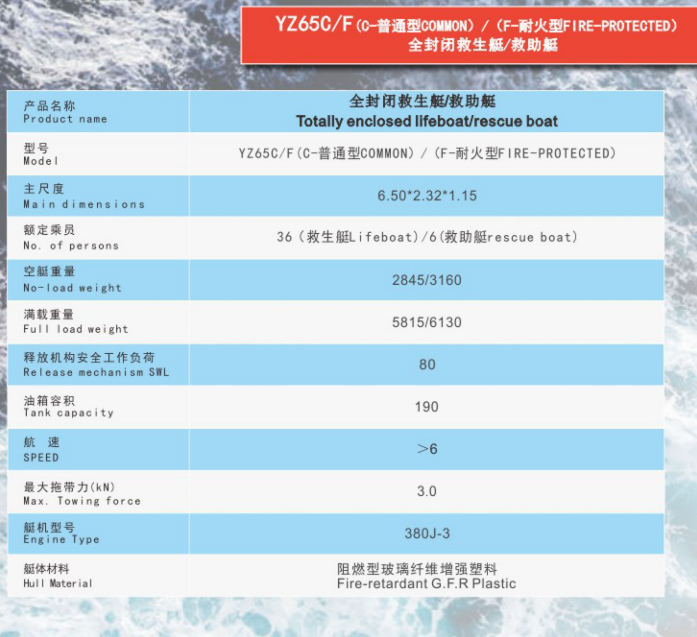
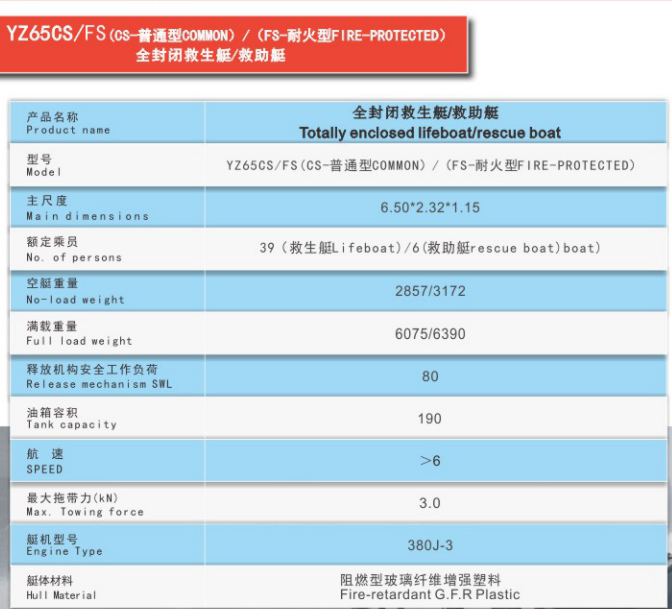
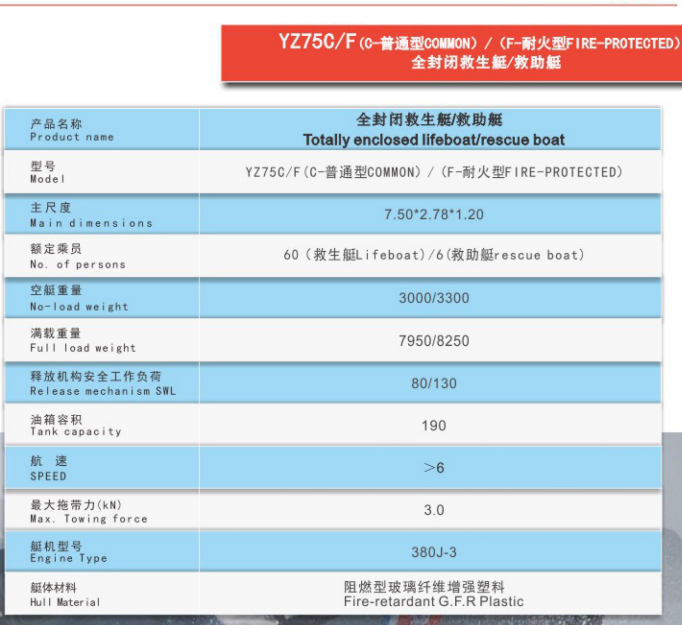

Free Fall Lifeboat
We also provide regular and fire-resistant free-fall lifeboats. They are available in 16, 20, 26, and 32-person free falling lifeboat.
Name | Free fall lifeboat |
Model | YZ49FC/FF (C: Common) / (F: Fire-resistant) |
Main dimensions | 4.90*2.18*0.70 |
No. of persons | 16P Lifeboat |
No-load weight | 2580*2870 |
Full load weight | 3900/4190 |
Release mechanusm (SWL) | 32.7 |
Tank capacity | 190 |
Speed | >6 |
Max. Towing force | 3.2 |
Engine Type | 380J-3 |
Hull material | Fire-retardant G.F.R Plastic |
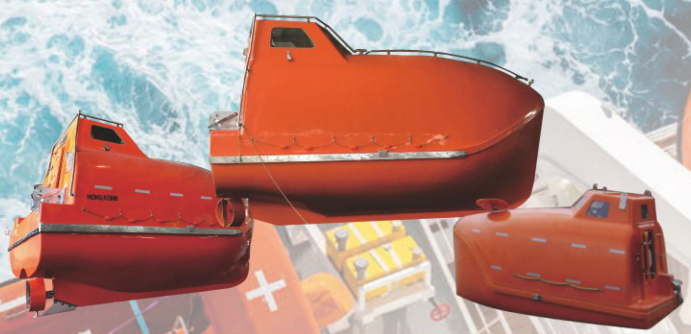

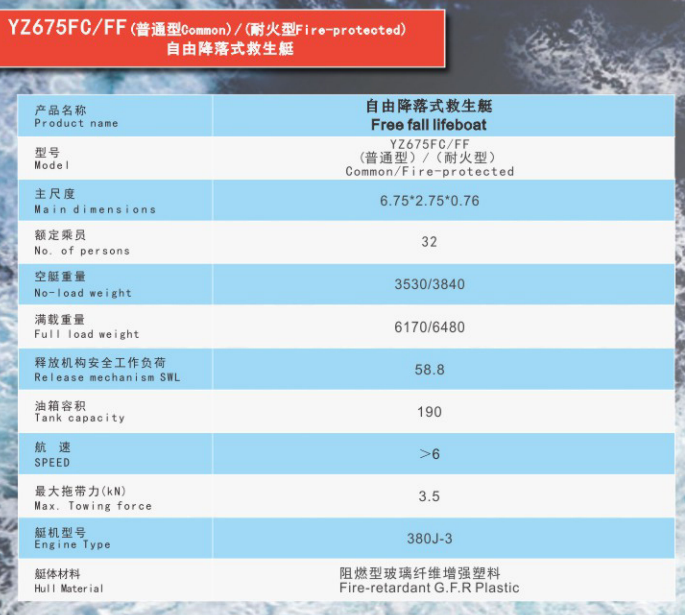
Fast Rescue Boat
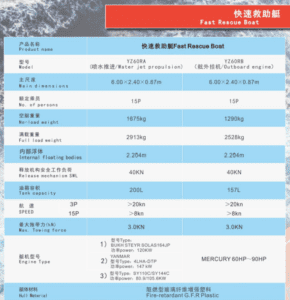

Types of Cargo Ship Lifeboat
1. Open Lifeboats on Ships
The open lifeboat is a traditional lifeboats on ships. It has no cover and can only be erected with a temporary canopy, which is poor in protecting the occupants. Open lifeboats are divided into motorboats and non-motor boats. A non-motorized open lifeboat without an engine. In addition to the oars and poles, there are sails and a mast ring (mast hoop) on the horizontal seat plate, a mast seat is provided on the bottom of the boat, and the edge There is a small eye ring for the mast support rope and the rope guide rope pulley.
2. Fully Enclosed Lifeboats on Ships
It is to add a rigid closed top cover on the basis of the open lifeboat, so as to ensure that the occupants are not affected by cold and heat. The hull of the fully enclosed lifeboat and the material of the rigid enclosed roof are both flame-retardant or non-combustible.
The crew can complete the retraction and release work under the closed cover and can row the oars. There is a passage cover at the entrance of the closed cover, which can be clamped when opened, and the occupants can quickly reach the seat without crossing the cross seat plate or other obstacles (for the cargo ship, all occupants can board the boat within 3 minutes).
It can be watertight when closed, and there is no significant water leakage when the lifeboat capsizes. The channel cover should be able to be opened and closed on both sides.
3. Partially Enclosed Lifeboats on Ships
The main difference between a partially enclosed lifeboat and a fully enclosed lifeboat is that it only has a rigid roof at the bow and stern. The length of the fore and the stern canopy is not less than 20% of the length of the boat. The middle part is provided with a foldable top cover, which and the rigid top cover of the head and tail form a windshield cover.
Partially enclosed lifeboats cannot be self-righting when they capsize. However, in case of capsizing, the occupants can escape and a climbing device similar to the open lifeboat is provided at the bottom of the boat for the occupants to climb and support.
Partially enclosed lifeboats need to be equipped with water scooping equipment or automatic water scooping equipment because the top cover is not watertight. Although there is no clear regulation on the speed of scooping water, the faster and more effective the better.
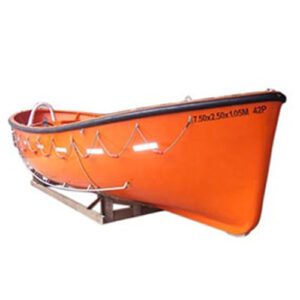
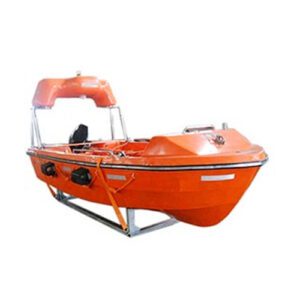
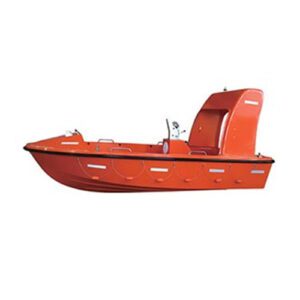
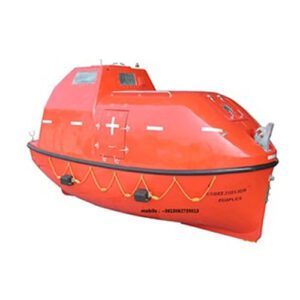
Construction of Ship Lifeboat
Marine Life boats can be divided into wood, steel, aluminum alloy, fiberglass and other types according to construction materials. FRP lifeboats are easy to build and maintain, and are currently the most commonly used.
Emergency Lifeboat can be divided into open, fully enclosed and partially enclosed according to different structural forms. When the open type encounters wind and waves above 4-5, the occupants will be attacked by seawater, and the occupants will be threatened with death when the temperature is low or exposed to the sun.
Therefore, the “1974 International Convention for the Safety of Life at Sea” requires passenger ships to be equipped with partially enclosed or fully enclosed lifeboats, and cargo ships and oil tankers should be equipped with fully enclosed lifeboats.
Emergency Life Boat Equipment List
1. Sufficient number of floatable paddles (more than 4), paddle racks or paddle forks. The oar frame or propeller fork should be tied to the boat with short ropes or short chains;
2. 2 boats with hooks;
3. Two bow cables with a length not less than twice the distance from the lifeboat storage position to the lightest sea line (not less than 15 meters), one of which is at the front of the bow and is connected to the release device; the other The root is fixed at or near the bow of the boat;
4. Two Taiping Axes, one at the end and one at the end;
5. One sea anchor, one anchor cable and one anchor cable each;
6. One floating scoop and two buckets can be used;
7. One hand pump;
8. There are 2 buoyant life-saving rings with a length of not less than 30 meters;
9. Several waterproof containers, containing 3 liters of fresh water for each occupant, of which 1 liter can be replaced by seawater desalinized;
10. A stainless water spoon with a short rope;
11. One stainless measuring cup;
12. Food rations that are packaged in airtight packaging and stored in waterproof containers, and rated at no less than 10,000 kJ per occupant;
13. A sailor’s knife tied to the boat with a short rope;
14. 3 can openers;
15. 1 set of fishing gear;
16. 4 rocket parachute flame signals;
17. 6 hand-held flame signals;
18. Two floating smoke signals;
19. One waterproof flashlight suitable for Mohs communication, together with a spare battery and a spare light bulb, are installed in a waterproof container;
20. One side of the daylight signal mirror includes instructions for communication with ships and aircraft;
21. One whistle or equivalent sound signal;
22. 1 lifesaving manual;
23. One water-proof life-saving signal graphic description table;
24. 1 set of first aid kits in the waterproof first-aid kit;
25. 6 doses of anti-sickness medicine per person and 1 clean bag;
26. One compass cabinet coated with luminous agent or with proper lighting device;
27. One searchlight that can illuminate for 6 hours and can be used continuously for not less than 3 hours;
28. One effective radar reflector;
29. Two pieces of heat preservation appliances, but not less than 10% of the rated crew;
30. Tools for small adjustments to the engine and its accessories;
31. One hand-held fire extinguisher suitable for extinguishing oil fires.
All attachments except for the hooked boat shaft which is not fixed for propping up the lifeboat, other attachments should be lashed and stored in the cabinet, in the cabin or fastened in other ways in the boat to avoid loss.
Rescue Boat Features
The lifeboat produced by our company is composed of multiple independent inflation chambers, a V-shaped keel, and many other accessories to ensure an effective and safe rescue operation.
It can be made into a foldable inflatable boat or a semi-rigid inflatable boat.
Lifeboats have good buoyancy, stability and navigation performance, and have greater safety than other life-saving tools; However, it has a large mass and occupies a large deck area and space.
How to Choose Lifeboat
All kinds of ships shall select emergency lifeboat and rescue boats according to different navigation areas and ship types, in accordance with the requirements of SOLAS Convention or ZS regulations, and taking into account the special requirements of the owner.
1. Life Save Boat on Cargo Ship
When the ship is equipped with two fully enclosed lifeboats, usually one lifeboat on the starboard side is also used as a rescue boat, which can save the equipment of one rescue boat. The selection of side door or rear door for a fully enclosed lifeboat shall be determined according to the arrangement of the ship wall. If the cargo ship adopts a free-fall lifeboat, since this type of boat can not be used as a rescue boat, another rescue boat must be equipped. Therefore, in general, the configuration of free-fall lifeboats is more economically expensive than the configuration of two hanger drop lifeboats.
2. Life Save Boat on Passenger Ship
Fully enclosed lifeboats are expensive, so passenger ships generally use partially enclosed lifeboats. However, free-fall lifeboats are not allowed for passenger ships. The partially enclosed or fully enclosed lifeboats selected by passenger ships can also be used as rescue boats if they meet the requirements of rescue boats at the same time.
Instant Quote Online
Dear friend, you can submit your pressing need online, our staff will promptly get in touch with you. If you have any questions, consult our customer service through online chat or telephone in a timely fashion. Thank you for your request online.
[86] 0411-8683 8503
available from 00:00 – 23:59
Address :Room A306, Building#12, Qijiang Road, Ganjingzi
Email : sales_58@goseamarine.com


